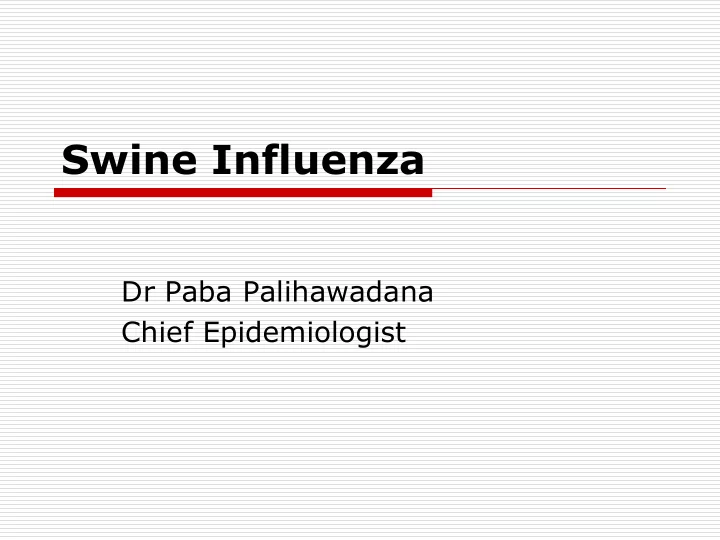

Swine Influenza Dr Paba Palihawadana Chief Epidemiologist
Swine Influenza Respiratory disease of pigs Caused by type A influenza viruses Humans do not normally get Rarly human infections can occur Swine flu viruses have been reported to spread from person-to-person
Swine Influenza outbreak From 17 th March to 25 th of April 2009, 878 cases of swine influenza with 60 deaths were reported in Maxico. Total of 7 laboratory confirmed cases have been reported in USA. A new strain of influenza virus sub type A/H1N1 responsible for this outbreak.
Transmission Spreads mainly from person to person through coughing or sneezing of people with influenza Sometimes people may become infected by touching something with flu viruses on it and then touching their mouth or nose. People usually get swine influenza from infected pigs Human-to-human transmission has occurred in some instances but was limited to close contacts Not been shown to be transmissible to people through eating properly handled and prepared pork
Symptoms of swine Influenza similar to the symptoms of regular human flu and include fever, cough, sore throat, body aches, headache, chills and fatigue. Can rapidly progress to severe and unusual pneumonia May cause a worsening of underlying chronic medical conditions. Infected people may be able to infect others beginning 1 day before symptoms develop and up to 7 or more days after becoming sick.
Treatment This virus is susceptible to antivirals like oseltamivir and zanamivir. The virus strain has been shown to be resistant to rimantadine and amantadine. Clinicians have to make decisions based on the clinical and epidemiological assessment and harms and benefit of the prophylaxis/treatment of the patient.
Measures taken by Epid Unit Develop fact sheet on swine Influenza and distribute to all the health institutions Alert airport/seaport health authorities regarding possible influx of infected cases Instructions were issued to airport/seaport authorities regarding preventive measures. Established surveillance system to detect suspected cases Collaboration with MRI established diagnostic facilities.
Recommend
More recommend